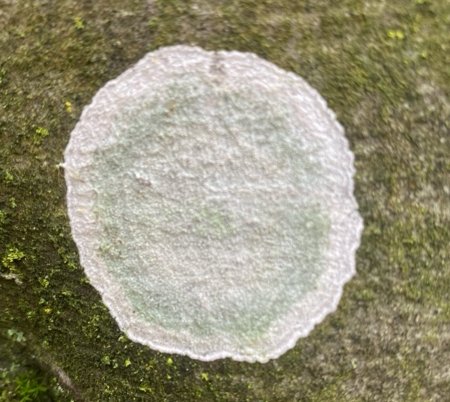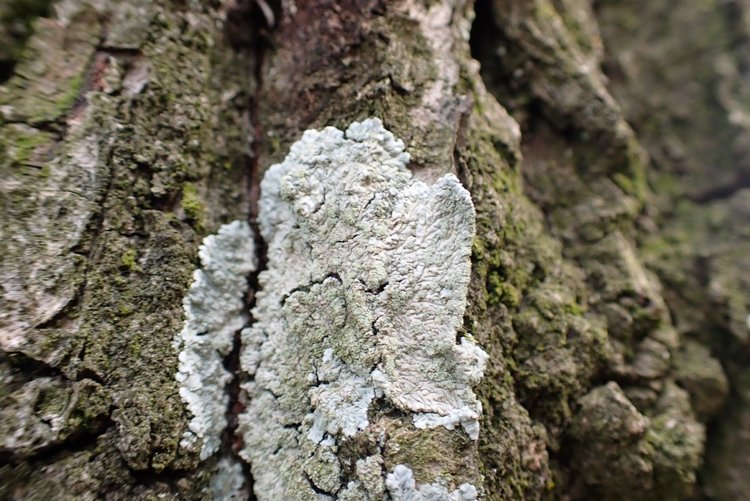If you’ve strolled down the campus lane, you’ve likely noticed the yellow, red, grey, and green patches on tree trunks. And what about the spots on the stones near the football field? Could it be chewing gum, or is it something else entirely?
It is not chewing gum: far from it! What you are seeing are lichens. Lichens are found in many sizes and forms across our beautiful campus. Upon closer inspection, you will notice their diversity in shape. Some lichens are disc-shaped, others resemble small shrubs, while some are speckled or even appear like tiny mushrooms. Look through a magnifying glass, and you will appreciate their intricate beauty.
What are lichens?
A lichen is not a plant, but a symbiosis of a fungus and an alga. The fungus and the alga cannot live without each other: the alga produces food and the fungus collects water. Nor are they parasites; they do not take nutrients away from the plant on which they grow. They do not invade the tree or wall, but live superficially. Lichens have fungal threads, not roots, stems, leaves or flowers.

Whitewash lichen (Phlyctis argena). Photo: Marja Horstman
Are lichens harmful?
There is a common misconception that lichens are harmful to trees, walls, or even rooftops. This is not the case: lichens merely use the surface as a habitat. Each species has its own habitat preference. Some thrive on trees, and it’s possible that a particular species will only grow on beech trees, for example. Others prefer hardwood. There are also lichens that exclusively grow on stone, often limited to specific types of rock (such as limestone, acidic, or basic). Nutrient levels and humidity play a significant role as well. Oak bark, for instance, is less nutrient-rich than elder bark.
Lichens are not parasitic and do not extract nutrients from the plants they grow on. They do not penetrate trees or walls but live superficially on their surfaces. A lichen is not a plant, but a symbiotic relationship between a fungus and an alga. The fungus and the alga depend on each other for survival: the alga produces food through photosynthesis, while the fungus gathers water. Lichens do not have roots, stems, leaves, or flowers but instead consist of fungal threads.
What makes lichens beneficial?
Lichens are beneficial for a variety of organisms. Some insects use lichens as shelter or as a food source, while certain birds incorporate lichens into their nests. In other regions, mammals consume lichens; for example, reindeer are particularly fond of reindeer moss (Cladina).
Even decayed lichens play a vital role. When their remnants fall to the ground, they contribute to the growth of other plants. Acting as ground cover, the decaying lichens provide nutrients for other living organisms. In this way, they help create new habitats for plants and animals alike. Lichens are also used in deodorants, toothpaste, ointments, extracts, and perfumes. In Japan, lichens are used in paints due to their antifungal properties.
Air quality
Lichens are a crucial indicator of air quality. Lichens respond swiftly to changes in their substrate, making them an important bioindicator, and useful as a tool for measuring air quality.
If you know enough about lichens, you can infer something about the air quality in each area. On our campus, most of the lichen species found are nitrogen-loving types. These species thrive in environments rich in ammonia and are often yellow or grey in color. However, ammonia and nitrogen are also among the main causes of other lichen species' decline. It is a delicate balance.
How many lichen species are there?
So, how many species of lichens could there be? The answer is: a lot! In the Netherlands alone, there are over 700 species of lichens, and globally, there are as many as 25,000 known varieties. The world of lichens is constantly changing—some species are disappearing, while new ones are being discovered. Lichens are among the longest-living organisms on Earth, with some capable of living for thousands of years.

Common orange lichen (Xanthoria parietina). Photo: Brechje Maréchal
So far, 89 species of lichens have been identified on our campus. These are mostly common species, and unfortunately, no rare species have been found yet. This is disappointing, but the campus has never been thoroughly examined by a specialist bryologist. With a detailed survey, more species could be discovered, including those that can only be identified under a microscope.
Together, we can ensure that more lichens make their home on our campus! Lichens grow very slowly and thrive on old trees, old roof tiles, old stones, and old walls that are not regularly cleaned. This gives them the chance to grow steadily over time.
Is it chewing gum after all?
Coming back to the chewing gum question—yes, it’s entirely possible that you saw something resembling chewing gum. There is a species of lichen on campus that genuinely looks like chewing gum! This species is aptly named the "chewing gum lichen" (Diploicia canescens). Curious? You can find it on the campus lane near the oak tree in front of house number 16. And while you're at it, take a look at the stone bridge and the walls near the campus entrance on Drienerlolaan. Here, you will find beautiful stone-loving species like Xanthoria calcicola (orange wall lichen) or Lenocara muralis (mural disk lichen). Enjoy!

Photo: Chewing gum lichen (Diploicia canescens)
Biodiversity at UT
Strengthening biodiversity on our campus is one of our sustainability goals at the University of Twente. By improving monitoring, we gain knowledge about biodiversity on campus in general, which helps us decide on the best ways to support it. In 2024, we started the yearly Bioblitz, in which anyone can help monitor species via the app ObsIdentify. Several activities were organised to raise awareness of biodiversity (such as bird observation). A biodiversity council was established, where CFM (Campus & Facility Management) consult with biodiversity enthusiasts on how maintenance can contribute to an improved habitat for species. Furthermore, thanks to a Climate Centre grant, we are working on making data on green maintenance and biodiversity accessible for research and education.
Would you like to find out more about sustainability at UT? Please go to utwente.nl/sustainability.





